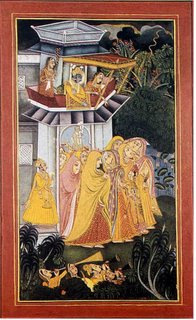Gangaur celebrations

Dodging the heavy traffic, travelling endlessly for an hour to Badi Chaupar, hearing the incessant honking, rubbing against agitated human bodies and bailing oneself out from the heavy police patrolling in the walled city. May sound like a lot of trouble but the bait, the festivity of Gangaur, was good enough.
Just a mere glimpse of the colourful extravagance in the form of a procession in the walled city was enough to make one forget about all of that. From trees to rooftops, car bonnets to motorcycle seats, the festivity raised everyone.
Gangaur is one of the most important festivals in Rajasthan, which is held each spring in honour of Gauri, the goddess of purity - considered to be the patron of unmarried girls.
“We read in the lonely planet about this festival. We learnt that the celebrations would be noisy and colourful - especially from the women. We came here to see that,” said Jonathan Taylor, an Australian tourist who is in the Pink city with his wife. The colourfully decorated idol of Gauri, standing atop an equally decorated buggy, had to pass through streets blazing with festivity. Jea Band’s musical perseverance was well acknowledged by the gathering - tunes including Manna Dey’s “Ajahun na aye balma.”
“The procession is taken out with fanfare. The preparations for this festival start two days after Holi. Poojas are done for 16 days. The unmarried young girls pray to goddess Gauri for a suitable match,” maker of the Jaipur panchang, Pundit Bansidhar Sharma said.
Local residents narrated tales on how traditionally, the youth considered this an opportunity of meeting each other freely - some even selecting partners and marrying. ”In Hindu mythology, Gauri is the unmarried goddess Parvati, before she married Lord Shiva. She performed this Pooja in order to marry the austere and emotionally invulnerable Lord Shiva,” Sharma said.
Though Gangaur festivities are associated with the entire state, celebrations in Jaipur, Udaipur, Bikaner, Jodhpur, Nathdwara and Jaisalmer are considered festive.

